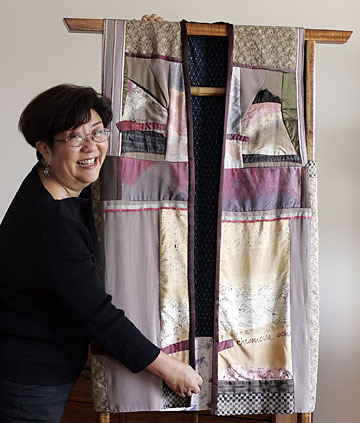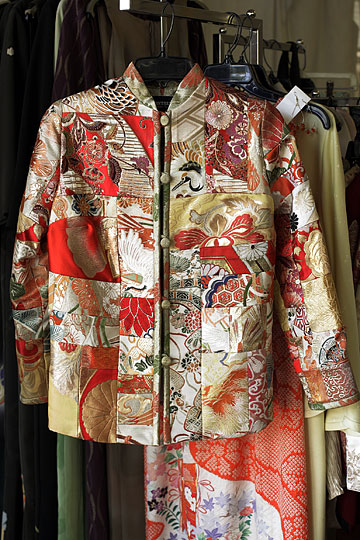
FL MORRIS / FMORRIS@STARBULLETIN.COM
Ann Asakura with a kimono she pieced together to tell a story of Japanese-American history in the islands. It was created for the traveling exhibition "From Bento to Mixed Plate."
|
|
Kimono awakening
People learn to cherish vintage garments that once were discarded
KIMONO RESCUER Ann Asakura vividly remembers traveling through Japan in 1979, dressed in a Western-style vest she had fashioned from a vintage kimono. While riding in a bus, she was aware of two elderly women pointing at her and giggling, and in talking to them, she discovered her cultural faux pas.
Following her Western mind-set, Asakura had used the fabric simply because "I liked the silk." But the fabric was from a men's kimono, and in Japan, where textiles, patterns and symbols speak a language of their own, that just wasn't done.
'BOLTS ...'
A fair of fabric and fun:
When: 9 a.m. to 1 p.m. Saturday
Place: Honpa Hongwanji Social Hall, Pali Highway
Admission: Free
Call: 536-4566
'ADAPTING THE KIMONO'
Taught by Ann Asakura:
When: 7 to 9 p.m. April 26, May 3 and May 10
Place: TEMARI, Center for Asian and Pacific Arts, 1754 Lusitana St.
Admission: $50
Register: 536-4566
Note: Bring a kimono and basic hand-sewing supplies. Basic sewing skills required; students will complete one garment.
|
Helping others navigate the intricacies of the kimono is an aim of her sewing workshop, "Adapting the Kimono," showing how to convert early-20th-century kimonos into 21st-century garments. The workshop takes place over three Wednesdays beginning next week.
"In Hawaii we have a really different way of thinking about and wearing" kimonos, she said. "People came here to work on the plantations. They came without money, without relatives. They came without the benefit of an older society to tell them what to do, so they had to create their own customs.
"When you look at old photos, it's hilarious because the women forgot how to tie kimonos. They really adapted to Western clothes because they had to work and it was so much easier to wear."
THOSE with an appreciation or curiosity about the kimono and its long journey from Japan to Hawaii can learn more during "Bolts ... of Fabric and Fun," a kimono fair at the Honpa Hongwanji on Saturday.

FL MORRIS / FMORRIS@STARBULLETIN.COM
Above, vintage kimono fabric and Chinese brocade are pieced together in a contemporary jacket from Montsuki.
|
|
The fair is free and will feature vintage garments, textiles and related supplies for sewing enthusiasts, quilters, costume designers and collectors. Special items include $5 bags of embroidered silk, jacquard linens and ikat remnants from Christina Kim of DOSA's Los Angeles atelier; kimonos from Robyn Buntin's collection, offered as a fundraiser for Gregory House; sashiko kits and threads from Japan; and natural indigo-dyed seersucker cotton from Shikoku island. Private collectors also have offered up wares for "Bolts ...," including vintage kimonos.
At Asakura's workshop, participants will learn about the kimono while completing one garment from kimono fabric. The timing is right, according to Asakura, who noted that fashions move in 20- to 25-year cycles and that the yonsei, people of fourth-generation Japanese ancestry in Hawaii, and youths in Japan have become interested in the kimono -- both for its legacy and as a matter of style.
At Montsuki the mother-and-daughter team of Janet and Patty Yamasaki rework antique and vintage kimonos and Japanese fabric into retail and Western-style couture creations. Patty said that over the past two years she's noticed brides wanting to incorporate their great-grandmother's or grandmother's obi into gowns.
"It's for the bride who wants something other than the traditional wedding dress but wants something Asian-inspired combined with cream fabric. Or they're incorporating vintage kimono to work with a color scheme," she said.
It was another story in 1979, when Yamasaki started working with her mother, and Asakura founded TEMARI, Center for Asian and Pacific Arts, to preserve and perpetuate the regions' textile arts.
"People were throwing this stuff away on sidewalks," said Asakura. "You could find it at Salvation Army for 50 cents. No one knew what it was worth and that it was their heritage they were dumping. I thought, 'Why are so many people throwing these things away? Why not use it in a way that's more than hanging it on a wall or hanging it on a bamboo rod?'"

COURTESY WILLIAM RENIO / STRICTLY PHOTGRAPHY
Tracy Taira shows her bridal gown, using kimono fabric in a color to match a green-and-white wedding theme.
|
|
It was the same in Japan, where she said, "You could find tons of kimono, el cheapo. But on my last trip a couple of years ago, I went to flea markets, shops I used to like in Kyoto, places in Tokyo, and came back with zero.
"It's really caught on. Over there, they use the fabric for quilts, interior accessories, and they love to make stuffed owls. They represent lovers because they're paired, like cranes."
KIMONOS WEREN'T the easiest of raw materials to use.
"It's a puzzle to take kimono fabric and make Western clothing," Asakura said. "You're also looking at a narrow piece of fabric that is really, really long. You might be lucky enough to find a bolt of fabric, but most of the time you're going to find it sewn into kimono."
Typically, bolts of fabric made in Japan were 28 inches wide, versus 44 to 60 inches wide in the West. Japanese patterns also tend to flow like a scroll, in a single, linear direction that adds a design challenge to any project.
The more Asakura understood the language of kimonos, the less likely she was to see them merely as raw materials.

FL MORRIS / FMORRIS@STARBULLETIN.COM
Theresa Tilley models a contemporary blouse sewn from vintage kimono fabric from Montsuki in Kaimuki.
|
|
"The kimono communicates social status, seasons of the year and gender. Married women and married men didn't want to be flashy, so the inside lining of their kimono were sometimes more beautiful than the exterior, and it was something only they knew. If you understand that, you're not going to put the kanji upside down or put a masculine image on a woman's back.
"People ask, 'How can you cut it?' and I say, 'With respect,' knowing you're gonna rescue something that will disintegrate if there's no one to protect it. People say, 'You're cutting family ties,' but to me it's preserving family ties by sharing grandma's obi, part of it used in a vest, another part used in a pillow, with something for everyone in the family."
In Japan, she said, the younger generation is not as superstitious as their elders, who would not think of wearing someone else's clothing. "They think the other person's spirit is imbued in the fabric."
If there is a bright spot in this new awakening, it's that kimono manufacturers that still exist in Japan have responded to demand.
"The market is being driven more and more by younger people," Asakura said, describing new designs incorporating metallic threads and fabric with holographic effects. "They're really trying to keep it young, otherwise the whole industry going die."

